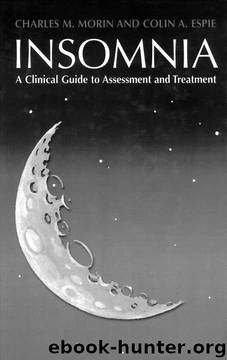Insomnia: A Clinical Guide to Assessment and Treatment by Charles M. Morin;Colin A. Espie

Author:Charles M. Morin;Colin A. Espie [Espie, Charles M. Morin;Colin A.]
Language: eng
Format: epub
Published: 2008-09-03T00:31:00+00:00
The DBAS is administered as part of the initial evaluation with other self-report measures (e.g., Insomnia Severity Index). For cognitive therapy purposes, you should highlight those items for which the patient's responses fall towards the upper quartile (i.e., tend to strongly agree with the statement). Again, while there is no right or wrong responses, the assumption is that a patient would benefit from changing his views or beliefs on those particular items. Another useful tool is the Glasgow Content of Thoughts Inventory (GCTI: Harvey & Espie, in press). The GCTI is reproduced in Appendix P. This instrument is derived from extensive work identifying the 'live' cognitions that insomniacs have while lying awake in bed unable to sleep (Harvey & Espie, in press; Wicklow & Espie, 2000). It is, therefore, a valid assessment of the nature of intrusive thought content and you may find it helpful to appraise your patient's pre-sleep thinking.
Download
This site does not store any files on its server. We only index and link to content provided by other sites. Please contact the content providers to delete copyright contents if any and email us, we'll remove relevant links or contents immediately.
Should I Stay or Should I Go? by Ramani Durvasula(7435)
Why We Sleep: Unlocking the Power of Sleep and Dreams by Matthew Walker(6362)
Fear by Osho(4496)
Flow by Mihaly Csikszentmihalyi(4493)
Rising Strong by Brene Brown(4195)
Why We Sleep by Matthew Walker(4193)
How to Change Your Mind by Michael Pollan(4115)
Too Much and Not the Mood by Durga Chew-Bose(4097)
The Hacking of the American Mind by Robert H. Lustig(4092)
Lost Connections by Johann Hari(3929)
He's Just Not That Into You by Greg Behrendt & Liz Tuccillo(3719)
Evolve Your Brain by Joe Dispenza(3506)
The Courage to Be Disliked by Ichiro Kishimi & Fumitake Koga(3263)
Crazy Is My Superpower by A.J. Mendez Brooks(3208)
What If This Were Enough? by Heather Havrilesky(3199)
Resisting Happiness by Matthew Kelly(3197)
Descartes' Error by Antonio Damasio(3167)
The Book of Human Emotions by Tiffany Watt Smith(3145)
In Cold Blood by Truman Capote(3140)
